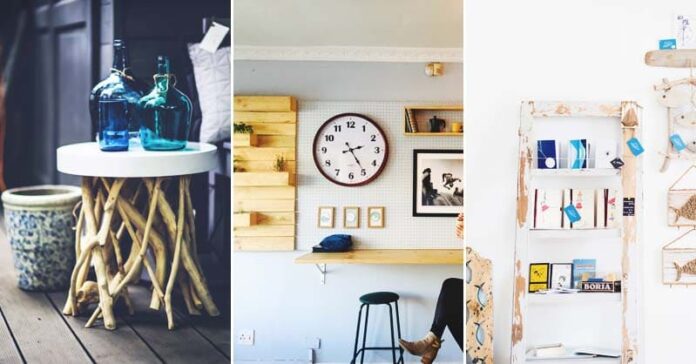The art of creating things out of wood, such as cabinets, furniture, joinery, carpentry, and woodturning, is known as woodworking.
For a fulfilling and artistic pastime, woodworking enables you to construct and personalize furniture, home accents, and other wooden objects.
Items needed
- Measuring tools such as tape measure, combination square, and marking gauge
- Cutting tools like hand saws, circular saw, jigsaw, and miter saw
- Shaping tools like chisels, planes, and rasps
- Drilling tools such as cordless drill, drill bits, and driver bits
- Sanding tools such as sandpaper, sanding block, and orbital sander
- Clamping tools like clamps and vise
- Finishing tools like brushes, rags, and finishing products like varnish, stain, or paint
Bear in mind the following process:
- Measuring and Marking: Precise labeling and measurement are essential to guarantee that materials will fit together correctly and for good results.
- Cutting: The ability to perform joint cuts expertly is the mark of exceptional woodworking workmanship. Joinery, the craft of forging robust and long-lasting bonds between wood components, calls for accuracy and dexterity in carrying out particular cuts that bear witness to a woodworker’s talent.
- Joining: Wood joinery is essential to creating high-quality work because it enables cabinetmakers to put various parts of a piece together into an aesthetically beautiful and structurally sound whole. Some common methods include butt joints, dovetail joints, and mortise and tenon joints.
- Sanding: Sanding is a crucial step in the painting process because it helps create small, rough ridges that the paint will adhere to, which add adhesion and help remove imperfections, also referred to as pimples. Sanding also helps prepare the surface for painting application.
- Finishing: Applying a particular type of liquid to the wood surfaces and allowing it to dry into a protective layer is the finishing process. By emphasizing the wood’s color and figure, this coating changes the way the wood looks, giving it a rich, exquisite appearance. Additionally, finishes shield the wood’s surface from debris and moisture in particular.
Be mindful of these:
- Wear Protective Gear: Users of woodworking machinery should wear a dust mask to protect their lungs from tiny particles that can enter them. These machines can produce a lot of dust. Wearing a respirator when spray painting or varnishing helps shield users from the potentially dangerous effects of the chemicals and don’t forget to get a hearing protection.
- Keep Tools Sharp: Sharp tools are easier to use in woodworking because they need less effort to make accurate and clean cuts hence be careful while using them.
- Work in a Well-Ventilated Area: Effective ventilation guarantees that all airborne bacteria, viruses, and other germs—including common viruses—are filtered out and it’s important especially important when using finishes and paints.
- Follow Manufacturer Instructions: To make good use of the tools and materials you using, make good use of the manufacturer’s instruction or guide provided.
You can try your hands on these after getting your materials and going through the process provided above
- Cut your wood to dimensions
- Mark the measurements on the plywood sheet using a pencil, measuring tape, straightedge, and ruler
- Stain or Paint your wood
- The two long pieces will create the shelf’s bottom and back. Glue them together at a right angle and secure them in place using wood clamps while the glue cures.
- Attach Sides
- After assembling the two sides, position the trim piece approximately 1 1/2 inches from the top on the shelf’s open side. To fasten it in place, use a nail gun. Before hanging your shelf, drill pilot holes in the back and fasten it to the wall using screws. To make sure it is straight, use a level. Think about putting the shelf on wall studs if you intend to use it for heavy things.
- Choose a Wood Type
- Measure and Cut Panels
- Build your birdhouse starting at the bottom. Allowing ¾ inch on each side to account for the thickness of the front and back panels, screw the side panels to the base.
- Drill four holes for drainage close to each corner of the floor panel using a ¼-inch bit. Next, drill two holes close to the upper (roof) edge of every side panel using a ¼-inch or ⅛-inch bit. They serve as ventilation.
- Cut Entrance Hole
- Install the Roof
- Add Wood Chips
- Mount Your Birdhouse
- Get Some Hardwood Offcuts
- Cut Your Boards to Length and the Same Approximate Width
- Prepare the Boards for Gluing and Finalize Your Design
- Glue Up the Board
- Flatten the Board and Trim It to Final Size
- Sand and Oil Your Board
- Cut boards and screen molding down to size
- Sand and Stain
- Create wooden frame
- Position your print, art, or photograph
- Add screen molding
- Patch holes
- Use sawtooth hangers to attach photo hanging hardware to the top center of each frame so that you could hang them up.
Source: www.Muzhchin.net
